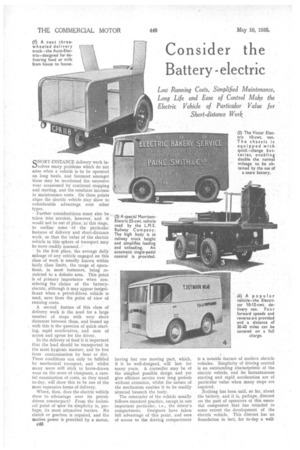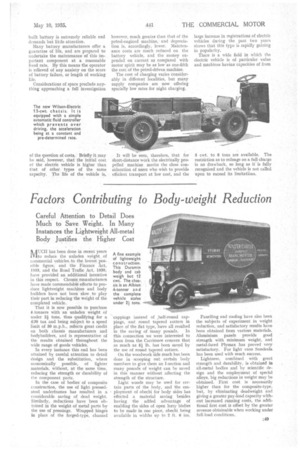Consider the Battery electric
Page 106

Page 107

If you've noticed an error in this article please click here to report it so we can fix it.
• et-TORT-DISTANCE. delivery work involves many. problems which do not arise when a vehicle is to be operated on long hauls. and foremost amongst these may be mentioned the excessive wear occasioned by continual stopping . and starting, and the resultant increase in maintenance costs. On these points .aloine the electric vehicle may show to considerable advantage over other types.
Further considerations.must also be taken into ac6oilrit,. however; and it would not be out of place, at this stage, to outline some of the particular featuresof delivery and short-distance work, so that the value of the electric vehicle in this sphere of transport may
be more readily assessed. ' •
In the first place,the average daily mileage of any vehicle engaged on this class of work is usually known within fairly close limits, the range of operations, in most instances, being restricted to a definite area. This point is of primary importance when considering the claims of the • batteryelectric, although it may appear insignificant when a petrol-driven vehicle is used, sav& from the point of view of running costs.
A second feature of this class of delivery work is the need for a large number of stops with very short distances between them, and bound up with this is the question of quick starting, rapid acceleration, and ease of access and egress for the driver.
In the delivery of food it is important that the load should be transported in the most hygienic manner, and be free from contamination by heat or dirt. These conditions can only be fulfilled by mechanical transport, and whilst many users still stick to horse-drawn vans on the score of cheapness, a careful examination of costs, as they stand to-day, will show this to he one of the most expensive forms of delivery.
Where, then, does the electric vehicle show to advantage over its petroldriven counterpart? From the technical point of 11,1eW its simplicity is, perhaps, its most attractive feature. No clutch or gearbox is required, and the motive.power is provided by a motor,
c18 having but one moving part, which, if it be well-designed, will last for many years. A controller may be of the simplest possible design and yet give efficient service over long periods without attention, whilst the nature of the mechanism enables it to be readily situated beneath the body.
The remainder of the vehicle usually follows standard practice, except in one important particular, Le., the driver's compartment. Designers have taken full advantage of this point, and ease of access to the driving compartment
is a notable feature of modern electric vehicles. Simplicity of driving control is an outstanding characteristic of the electric vehicle, and its Instantaneous starting and rapid acceleration are of particular value when many stops are required.
Nothing has been said, so far, about the battery, and it is, perhaps, distrust on the part of operators of this essential component that has retarded to some extent the development of the electric vehicle. This distrust has no foundation in fact, for to-day a well built battery is extremely reliable and demands but little attention.
Many battery manufacturers offer a guarantee of life, and are prepared to undertake the maintenance of this important component at a reasonable fixed rate. By this means the operator is relieved of any anxiety on the score of battery failure, or length of working life.
Considerations of space preclude anything approaching a full investigation of the question of costs. Briefly it may be said, however, that the initial cost of the electric vehicle is higher than that of other types of the same capacity. The life of the vehicle is, however, much greatea than that of the petrol-engined machine, and depreciation is, accordingly, lower. Maintenance costs are much reduced on the battery vehicle, and the money expended on current as compared with motor spirit may be as low as one-fifth the cost of the petrol-driven machine.
The cost of charging varies considerably in different localities, but many supply companies are now offering specially low rates for night charging.
It will be seen, therefore, that for short-distance work the electrically propelled machine merits the close consideration of users who wish to provide efficient transport at low cost, and the large increase in registrations of electric vehicles during the past two years shows that this• type is rapidly gaining in popularity. There is a wide field in which the electric vehicle is of particular value and machines having capacities of from
5 cwt. to 6 tons are available. The restriction as to mileage on a full charge -is no drawback, so long as it is fully recognized and the vehicle is not called upon to exceed its limitatiOns.




































































































































































